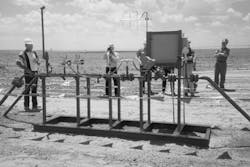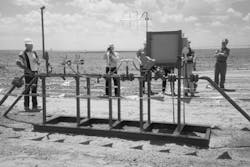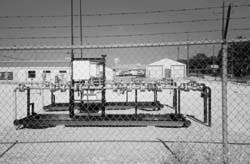Guntis Moritis
Production Editor
For the West Brahaney CO2 flood, Fina has lowered the injection skid cost by installing 1-in. stainless steel valves, meter, and choke. The picture was taken during the flood's dedication ceremony in July.
Larger stainless steel injection skids, such as these near the main street of Denver City, Tex., are common in the large CO2 floods started in 1980s. These skids are in Shell's Denver Unit.
Oil producing companies expect carbon dioxide injection to delay, by 10-20 years, the abandonment of nearly depleted waterfloods in the West Texas area.
They calculate that CO2 injection may recover at least 7-10% of the original oil in place. This resource, otherwise, would remain in the ground.
Some reasons producers are venturing into CO2 flooding are:
- Existing waterfloods are becoming uneconomical because of high water cuts.
- CO2 supply infrastructure operators in West Texas are providing contracts that reduce a producers risk. This helps the economics for smaller size projects.
- CO2 price compared to a few years ago is relatively low, now said to be in the mid-$0.60/Mscf range.
- Project development costs have fallen because industry experience over the past 10 years shows that more standard oil field equipment can be used.
- Computer CO2 flood performance predictions have improved.
New projects
One company active in initiating CO2 floods is Fina Oil & Chemical Co.
Fina, on May 17, started CO2 injection in the East Penwell San Andres Unit, Ector County, Tex., followed on June 18 with CO2 injection in the West Brahaney San Andres Unit, Yoakum County, Tex. (Fig. 1 [35965 bytes]).
In early August, Fina started injecting CO2 into a third project, the Emmons lease, South Cowden field, Ector County, Tex. Fina's Emmons lease development is a cooperative venture with Phillips Petroleum Co.'s South Cowden Unit CO2 flood. Both project start-ups had a common dedication on Aug. 13.
Starting three CO2 floods in 1 year is the most for a single company since the mid-1980s when in 1 year Amoco Production Co. kicked-off four and Exxon Co. U.S.A. three (OGJ, Apr. 15, p. 56).
Fina is also studying the possibility of CO2 floods, in 1997, in the following three fields: North Robertson and ODC fields, Gaines Co., Tex., and Garza field, Garza County, Tex.
Some other new CO2 floods planned for West Texas and Eastern New Mexico in the next year are:
- Phillips Petroleum Co., State 35 Unit in the Vacuum field, Lea County, N.M.
- Oxy USA Inc., West Welch, Dawson County, Tex., and North Dollarhide, Andrews County, Tex.
- Texaco Inc., Harris and Robertson fields, Gaines County, Texas, and Vacuum field, Lea County, N.M.
- Amoco Production Co., Anton Irish, Hale and Lamb counties, Tex.
- Unocal Corp., Reinecke field, Borden County, Tex.
Penwell
The Penwell field, discovered in 1927, lies about 15 miles southwest of Odessa.
Primary oil production from the 3,200-acre East Penwell (San Andres) Unit, formed in 1967, totals 30 million bbl. Waterflooding, which started in 1969, recovered another 20 million bbl.
From Phase 1 of the CO2 project, Fina expects to recover 3.1 million bbl of additional oil. Increased oil potential on a unit-wide basis is 9.2 million bbl, according to Fina.
The San Andres carbonate formation has a 4-md permeability, 10% porosity, 140-ft net pay thickness, 4,000-ft depth, and a 77% initial water saturation.
The produced 34° API oil is sour with a 2-cp viscosity and a 400 scf/bbl GOR. Production from 93 wells prior to initiating CO2 injection was about 1,550 bo/d and 23,873 bw/d with 23,779 bw/d being injected into 51 wells. The wells are on a line drive and inverted nine-spot pattern.
The $1.27 million Phase 1 involves 18 producing and 7 injection wells and includes a 7,500 ft, 4-in. lateral to the nearby Enron Liquids Pipeline's Central Basin pipeline.
West Brahaney
West Brahaney field, discovered in 1945, is about 3 miles southwest of Plains, Tex.
Primary oil production from the 4,920-acre West Brahaney (San Andres) Unit, formed in 1965, totals 3.3 million bbl. Waterflooding, commencing in 1969, recovered another 8.3 million bbl.
From the $4 million Phase 1 of the CO2 project, Fina expects to recover 1.7 million bbl of additional oil. On a unit-wide basis, Fina estimates a 6.7 million bbl oil-recovery potential.
Average rock properties of the producing San Andres carbonate are 2-md permeability, 10% porosity, 50-ft net pay thickness, 5,300-ft depth, and a 66% initial water saturation.
The produced 33° API oil is sour with a 2-cp viscosity and a 300 scf/bbl GOR. Production from 52 wells prior to initiating CO2 injection was about 577 bo/d and 2,500 bw/d with 7,000 bw/d being injected into 46 wells. The wells are on a five-spot pattern.
Phase 1 encompasses 15 producing and 8 injection wells. For CO2 supply, Fina constructed a, $750,000, 9 mile, 6-in. pipeline to Shell Western E&P's Allred station, near Denver City, Tex. The Cortez pipeline connects the Allred station to the McElmo Dome CO2 field in southwestern Colorado.
Because of the high injection pressure, Fina needed to install a $300,000 CO2 pressure boosting station. Currently, the pipeline delivers CO2 at 1,900 psi and the two electric triplex pumps boost the pressure to about 2,200 psi. The current CO2 delivery rate is about 3 MMscfd.
As more CO2 is injected, Fina expects the delivery pressure to fall to about 1,600 psi. Fina says the pipeline has sufficient capacity to deliver CO2 to other operators in the area who may want to inject CO2.
In an innovative contract with Shell, Fina traded some working interest in the unit for a fixed amount of carbon dioxide.
South Cowden
Both Phillips and Fina are cooperating in the development of CO2 projects in the South Cowden field. Phillips' South Cowden Unit project is partly funded by the U.S. Department of Energy's technology transfer program for Class II shallow shelf carbonate reservoirs. Its CO2 project encompasses about 2,000 acres out of a total of 4,000 acres in the South Cowden Unit.
In South Cowden, Phillips will test the feasibility of horizontal CO2 injection wells. Phillips expects each horizontal well to replace two to four vertical injection wells.
If CO2 enters only a limited portion of the 5 in., open hole lateral, Phillips has several options that include foam diversion, gel polymers, or mechanical means such as open hole packers to improve the injection profile.
Phillips invested, not including CO2 which is not capitalized, about $7 million in the project. DOE added about another $3 million. DOE will also provide $4 million for project expenses.
Project profitability was significantly improved by outsourcing the recycling plant that will provide dehydration and recompression of the produced gas from both Phillips' and Fina's operations. Production Operators Inc. will own and operate the facility.
Production in the South Cowden Unit is expected to increase to 1,700-1,800 bo/d from the current 400 bo/d. The water cut in the unit was over 95%, and Phillips does not believe that it could have continued to produce without the CO2 injection.
Phillips expects the CO2 project to recover 7 million bbl of oil. The field had previously produced about 35 million bbl of oil, 10 million bbl under primary production and 25 million bbl after water injection started in 1965.
The Odessa lateral, a 13 mile, 6-in. pipeline built by Morgan Associates, Kansas City, connects South Cowden with the Central Basin pipeline. Morgan owns a small interest in the Cortez pipeline. Enron will operate the Odessa lateral.
Phillips plans to inject between 11 and 15 MMscfd with Fina injecting about 8 MMscfd of CO2. Phillips says that the Odessa lateral has additional CO2 capacity that other nearby operators could use.
The cooperative venture between Phillips and Fina includes sharing three lease-line injectors.
Fina's South Cowden Emmons lease CO2 project covers 665 acres and includes 12 producing wells, 6 interior injection wells, and the 3 injection wells shared with Phillips.
Because of shared facilities and wells with Phillips, Fina's gross investment in the project was only $994,000. It expects an incremental oil recovery of 2.9 million bbl. About 22.9 million bbl of oil have been recovered from this unit's area since production began in 1933. After the unit was formed, waterflooding started in 1970.
Current production is 500 bo/d and 15,800 bw/d from the 2-md San Andres carbonate at about 4,600 ft depth. GOR is 200 scf/bbl.
CO2 supply
Although West Texas is seeing considerable interest in CO2 demand, Delhi Gas Pipeline Corp. reduced some CO2 delivery capacity after acquiring 82 miles of 12 and 16-in. CO2 pipeline from Canyon Reef Carriers Inc. and converting the line to natural gas service.
The pipeline could deliver CO2 from four natural gas plants in the south part of West Texas. The plants will now have to resume venting CO2, estimated at about 50 MMscfd.
At present, CO2 supplies are tight, but will increase by about 300 MMscfd after Shell Oil Co. completes a drilling program to boost deliverability from the McElmo Dome CO2 field of Southwest Colorado (OGJ, June 17, p. 20). The 500 mile Cortez pipeline transports the CO2 to a terminal near Denver City, Tex.
Tighter CO2 supplies are said to have increased the CO2 price at Denver City to around the mid-$0.60/Mscf from the mid-$0.50/Mscf just last year. This price is still substantially less than the $1/Mscf, or more, that existed in the 1980s.
Buyers and sellers negotiate the CO2 price for each contract and keep actual price information confidential.
Copyright 1996 Oil & Gas Journal. All Rights Reserved.




